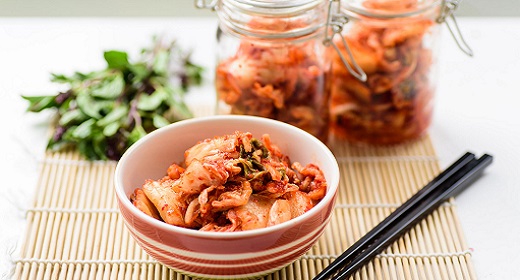by Ocean Robbins: You may have seen jars of kimchi at the grocery store and wondered whether to try it. Here’s everything you need to know about kimchi and its health benefits…
We are proud to announce a new partnership with John and Ocean Robbins and the Food Revolution to bring our readers Summits, Seminars and Masterclasses on health, nutrition and Earth-Conscious living
Sign up today for Plant Powered and Thriving
When I think of the great human inventions, fermented food is right up there with the wheel, the printing press, and the dogbrella. Imagine being able to keep vegetables safe and edible for weeks or months without refrigeration! Plus, many fermented foods are delicious. And as a bonus, the bacteria responsible for this feat support our gut health. Win-win!
One of the yummiest fermented dishes of all time comes from Korea. It’s called kimchi, and you can think of it as sauerkraut’s spicier, more colorful cousin. It’s a flavorful blend of vegetables, salt, and seasonings, which you can make at home and increasingly find at specialty stores and upscale supermarkets.
But how exactly is kimchi made, and does it provide any health benefits? Read on to find out if it’s worth adding to your diet.
What is Kimchi?
The name “kimchi” comes from the Korean word “chimchae,” which means “vegetables soaked in brine.”
Kimchi is a fermented food that is naturally rich in probiotics (good bacteria for your digestive system). It’s made through a process called Lacto-fermentation, just like sauerkraut and traditional dill pickles. Lacto-fermentation doesn’t have anything to do with milk; instead, it utilizes the bacterium Lactobacillus to digest sugars into lactic acid, which gives the kimchi its characteristic sour flavor.
Kimchi is often colorful. You can make it from cabbage, radishes, and other vegetables, all of which are super healthy and delicious. Seasonings include Korean red chili pepper flakes, garlic, and ginger, which all have great health benefits. Many traditional kimchi recipes also use salted shrimps and anchovies for flavoring, but there are vegan versions as well.
Kimchi Qualities
Kimchi is low in calories and has a high water content, but it’s often high in sodium as a result of a salt-based fermentation process. While overall nutrition varies depending on the recipe and ingredients used, in general, kimchi is a good source of many vitamins and minerals, including vitamin A, vitamin C, vitamin K, vitamin B6, folate, iron, and manganese. Depending on the brand or recipe, kimchi can also sometimes contain added sugar.
Oh, and kimchi isn’t a food as much as an entire food group; there are around 200 different varieties of kimchi today. Different regions around the world use different ingredients, largely depending on what’s available to them.
Kimchi also has a strong odor and taste. It’s often described as having a sour, spicy, salty, and even umami — or savory — flavor. When you open a jar of kimchi, you’ll find that it has a potent, garlicky, sulfur-like smell. You may find kimchi, like many other pungent foods, to be an acquired taste. But when you learn about its many health benefits (stay tuned!), you’ll see that it’s a taste very worth acquiring.
Origin of Kimchi
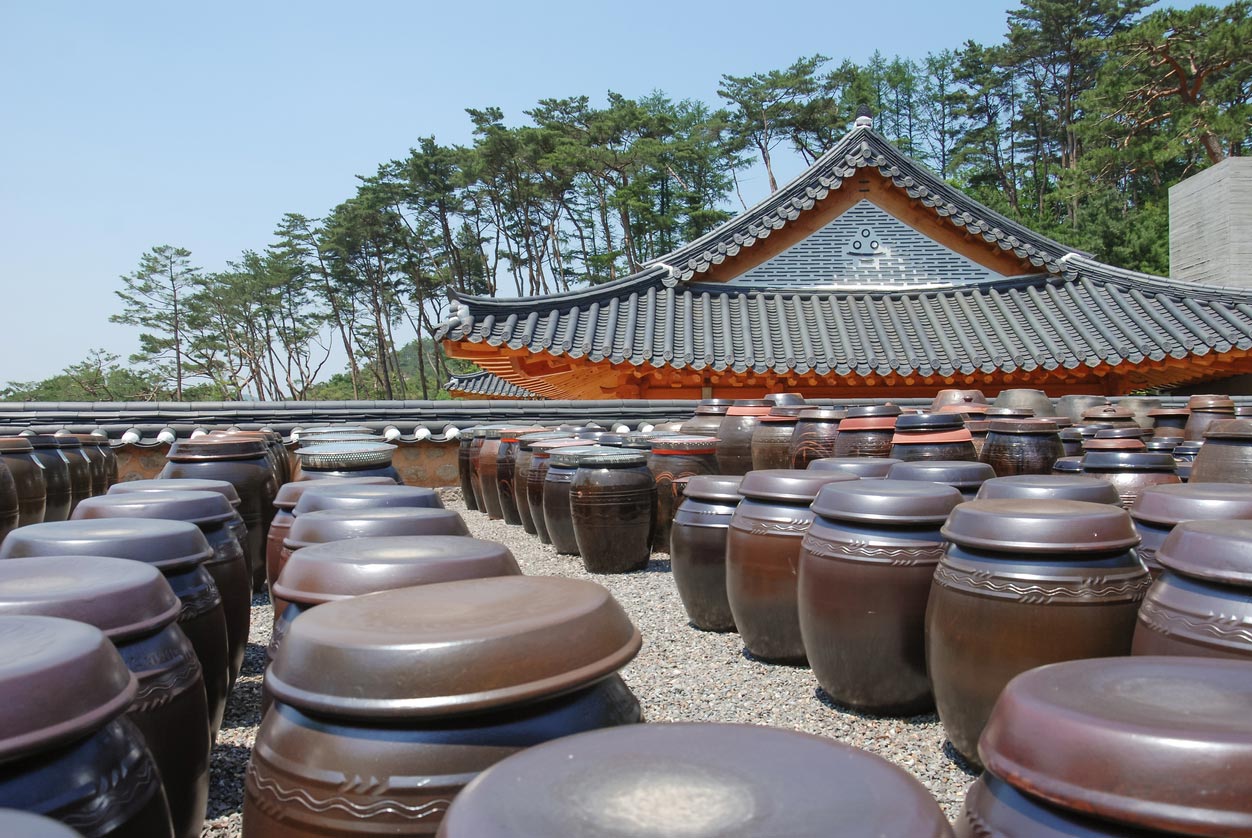
The roots of kimchi are lost in the mists of time. Although the question will probably employ historians for the foreseeable future. Since the Korean language did not have a written analog until roughly 600 years ago, the origin of the word “kimchi” doesn’t help us date its origin. Some scholars assert it originated around 4,000 years ago in Korea. While others say, it came about sometime between 918-1392 A.D. Some argue that kimchi came about during the Japanese invasion of Korea in 1592 with the introduction of red pepper. And others say that modern kimchi as we know it today is only 100 years old. But this last argument is widely disputed. Most evidence points to the fact that kimchi originated thousands of years ago.
Whatever the historical truth, there’s no debate that kimchi is a cultural staple in many Korean families and communities today. In fact, beloved kimchi recipes are passed down in families from one generation to the next.
In Korea, kimchi is a rich piece of “gastrodiplomacy,” or the practice of using food to foster relationships between nations and resolve disputes peacefully. The tradition of making kimchi — and bringing community together — actually has a name in Korean: Kimjang.
Kimjang has historically brought together entire villages and communities, primarily to turn hundreds of heads of cabbage into a long-lasting and microbiome-boosting source of nutrition. The ritual of Kimjang is so important for the Koreas that in 2013, UNESCO added it to its list of the intangible cultural heritage of humanity.
Kimchi Health Benefits
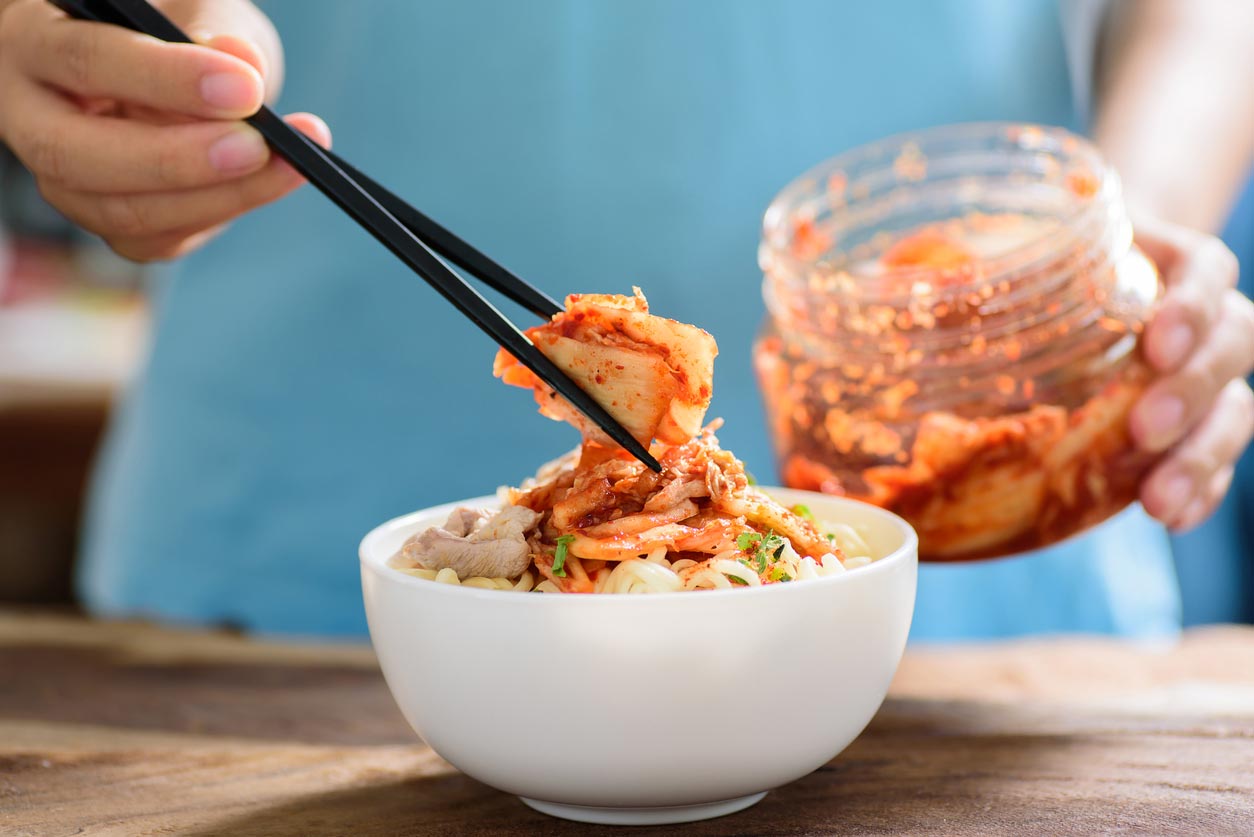
The biggest health benefits kimchi offers have a lot to do with its abundant probiotics. Kimchi contains many strains of probiotics, primarily from the Lactobacillus family. But unlike the countless probiotic supplements you can find on grocery store shelves — which usually only provide a handful of probiotic strains and are thus something of a monocrop — fermented foods like kimchi can provide millions of distinct varieties of live microbes. It’s this diversity in microbes that turns out to be of greatest value to your gut health.
Diversity is so great because the wide variety of strains make sure that a problematic strain of bacteria can’t take over your gut and create harm. No matter what comes along, there’s always an antidote to keep it in its place! With all those varieties fighting it out for limited resources, the good bacteria can keep the not-so-good ones in check.
So, what health benefits does kimchi provide, specifically? Quite a few, actually!
Kimchi may strengthen your immune system.
Especially when made with traditional ingredients like ginger, garlic, and red pepper. It’s chock full of immune-boosting antioxidants and plant compounds such as phenolics and flavonoids.
Kimchi is generally good for digestive health.
Due to its high fiber content and large concentration of lactic acid bacteria, kimchi is good for your gut. A compound in kimchi called sulfur-methyl-L-methionine may even help prevent damage to your intestinal lining. Kimchi also appears to have therapeutic effects on peptic ulcer disease and stomach inflammation caused by H. pylori bacteria, largely by preventing harmful germs from attaching to digestive cells.
Kimchi appears to have anti-inflammatory and anti-aging properties.
Kimchi is rich in antioxidants like vitamin C, which has been studied for its ability to slow the oxidative damage to skin. A 2011 test-tube study in Food Science and Biotechnology found that kimchi helped regulate the oxidative process of cells, slowing inflammation and potentially the aging process. And animal studies have found the strain Lactobacillus Plantarum — found densely in kimchi — to be especially effective in lowering inflammatory markers. Although more research is needed to be sure if the same benefit occurs in people.
Kimchi may have antifungal properties.
Several strains of Lactobacillus have been studied for their ability to fight Candida, a fungus that causes yeast infections when it grows excessively.
Eating kimchi may aid with weight loss.
Likely due to its high fiber content and gut-friendly bacteria, kimchi may help you lose weight. A 2011 study published in Nutrition Research fed 22 overweight or obese adults fresh and fermented kimchi for four weeks, separated by a two week washout period, to see which variation of kimchi had more weight loss benefits. Researchers found that fermented kimchi had a slightly more significant positive effect on risk factors for metabolic syndrome, such as systolic and diastolic blood pressures, percent body fat, and total cholesterol, than fresh kimchi. Fermented kimchi also helped lower blood sugar.
Kimchi may have anticancer benefits.
A 2008 study by the FAO found that kimchi varieties made with red pepper seed were high in antioxidants, which help protect your cells from oxidative damage that can lead to diseases like cancer. And cabbage is a cruciferous vegetable, a family of veggies known to be rich in glucosinolates, compounds that break down to form isothiocyanates, which are known to have anticancer potential.
Kimchi could be good for your heart.
Some studies have found that Lactobacillus isolated from kimchi may help lower LDL “bad” cholesterol. Kimchi traditionally uses garlic in its fermentation process, which contains selenium and allicin, two compounds known to have heart health benefits like reducing inflammation and protecting your artery walls.
Kimchi contains compounds that may improve your skin.
Lactobacillus bacteria have been studied for their positive impacts on atopic dermatitis or eczema. Animal studies have shown a similar effect, reducing skin inflammation, irritation, and mite-induced dermatitis in mice when fed the bacteria.
Kimchi Controversy
Kimchi may be a delicious, healthy food, but it’s also a flashpoint in a bitter cultural conflict.
Kimchi, as we’ve seen, is a traditional Korean dish. In fact, it’s the national dish of both North and South Korea. According to the Ministry of Agriculture, Food, and Rural Affairs, exports of kimchi reached a record high in January 2020, increasing 30% in just one year. The majority of it, around 90%, was exported from South Korea to Japan.
Japan has become such a fan of kimchi that they’ve also begun to make their own. This has created some political conflict, considering that the Empire of Japan invaded Korea from 1910-1945 and tried to eradicate its culture. As a result, Koreans see this as subverting their national dish and want Japan to name their version of kimchi something else.
Japanese kimchi manufacturers don’t often make it in the traditional style. Instead, they also add things like citric acid, rice paste, guar gum, and alcohol. In essence, some Japanese companies are turning kimchi into something of a processed food.
There are also a lot of kimchi flavored processed foods, like ramen noodles, potato and tortilla chips, bagged popcorn, pork rinds, and flavored soda. Don’t be fooled, though, as none of these products contain the health benefits offered by kimchi in its original state.
Where to Find Kimchi
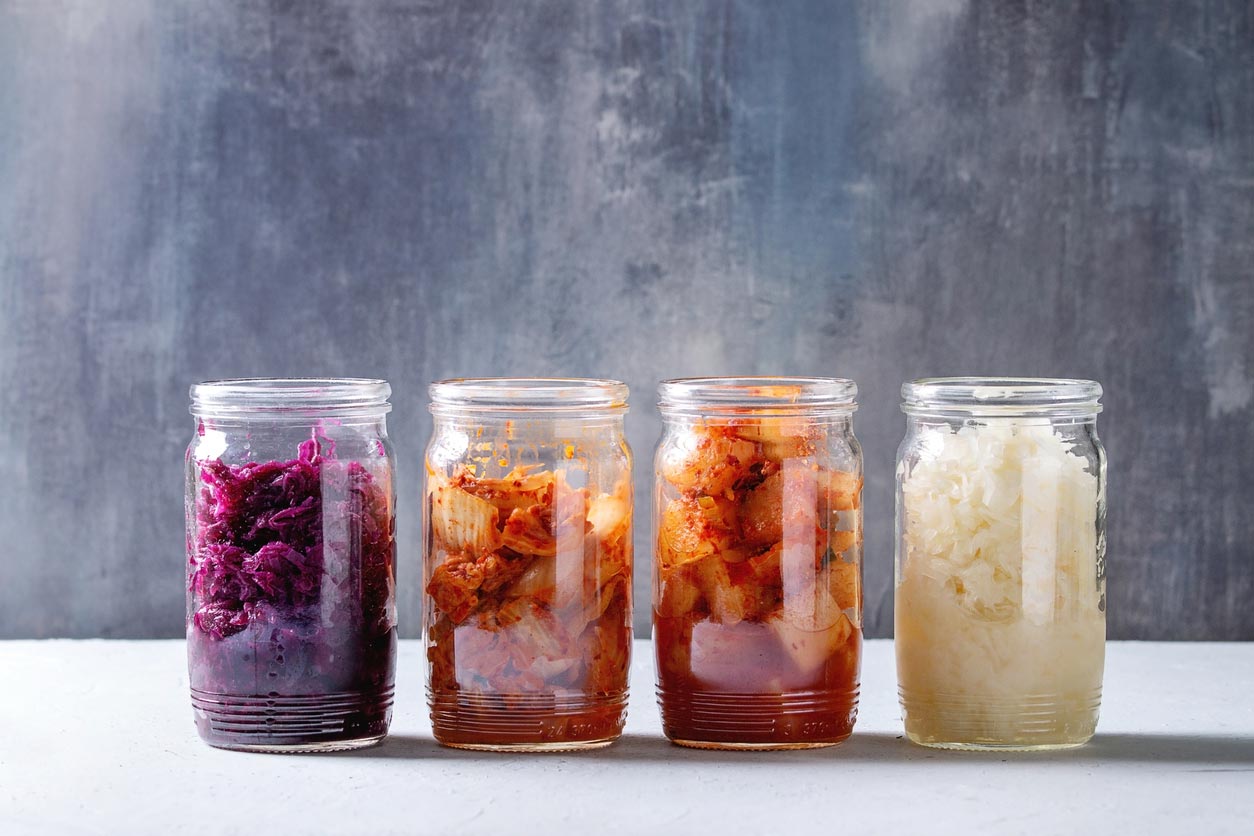
You can find kimchi in a wide variety of mainstream outlets, including the refrigerated sections of larger grocery stores. Look for it near the tofu, tempeh, and miso.
Many Korean markets and restaurants will also offer kimchi. If you like it, some Korean restaurants will also sell bottles of house-made kimchi that you can purchase.
In many parts of the world, kimchi is available online. A couple of popular vegan varieties (made without animal products) in North America include Madge’s Premium Vegan Spicy Kimchi and Small Town Cultures Turmeric Kimchi.
How Long Does Kimchi Last?
Kimchi needs about two full weeks in the refrigerator to ferment before it develops its best flavors. After that, it will continue to age in the fridge and will stay tasty for a couple of months.
Many Koreans actually have kimchi refrigerators, designed specifically to meet the storage requirements of traditional kimchi and facilitate different fermentation processes.
How to Make Kimchi
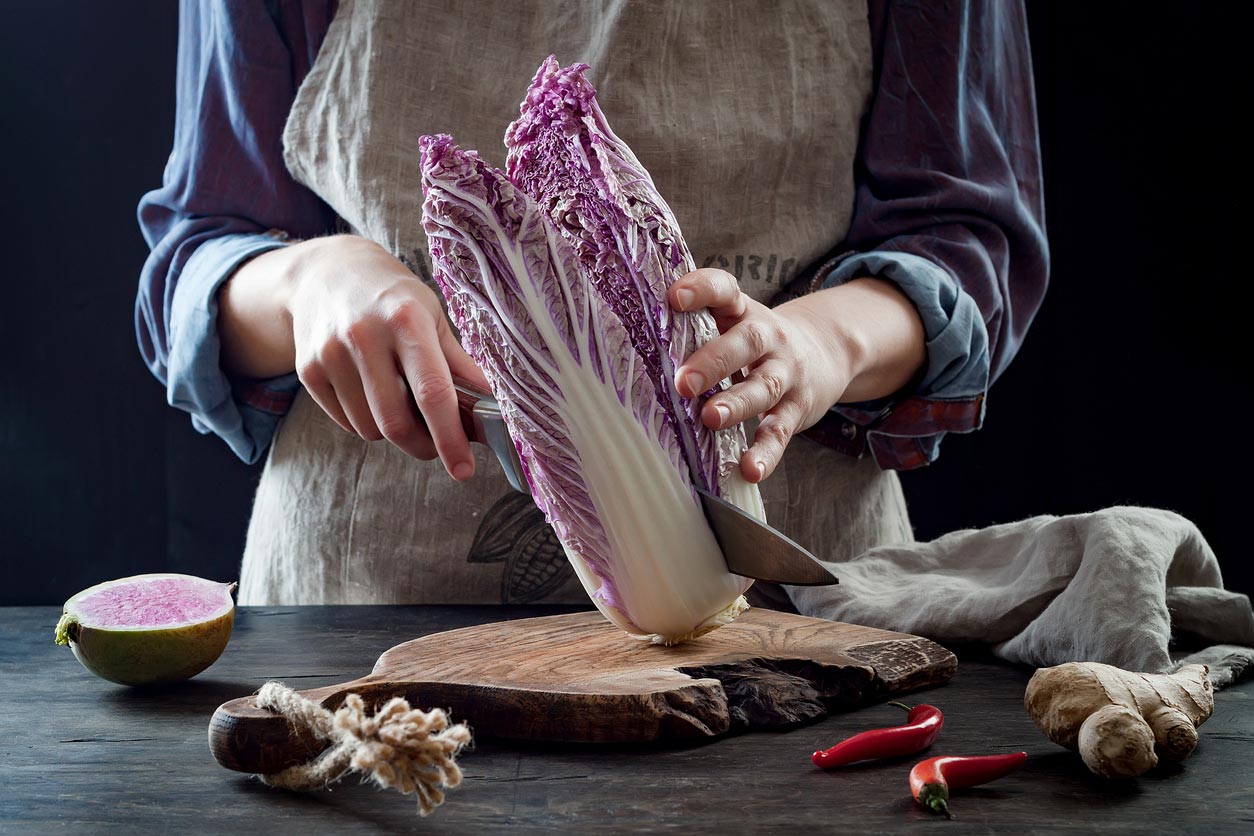
You can also try making kimchi yourself, experimenting with different flavors and ingredients. Here is a video showing how to make a vegan version of traditional kimchi with napa cabbage and daikon or Korean radish.
Kimchi recipes will vary according to what kind of kimchi you’re making, and personal taste, but here a variety of recipes to help you get started.
Vegetarian Kimchi by Maangchi – This is a traditional recipe that can be made vegetarian or vegan.
Vegan Kimchi by Korean Bapsang – This is a vegan kimchi variation of a traditional kimchi recipe, using Asian pear and pumpkin puree to sweeten it, along with scallions, mustard greens, and Korean radish.
Easy Raw Kimchi by Nest & Glow – While kimchi is most often associated with Asian greens and radishes, you can really kimchi any vegetable. This recipe uses a variety of more readily available veggies, including red peppers, carrots, and celery, so it could be a great choice if this is your first kimchi foray!
How to Use Kimchi

Kimchi is so delicious and versatile that you can add it to just about anything.
Traditional Korean recipes use kimchi for flavoring, which means that sometimes it gets cooked. Keep in mind that heating kimchi, or any other fermented food, over 115°F will actually start to kill off the healthy probiotics. One way to avoid this is to add it to the end of the cooking process — or to serve kimchi over already-cooked foods.
Some other ways to enjoy kimchi include:
- As a side dish, eaten raw and on its own like (for example, Banchan in restaurants)
- Over quinoa or other grain-based dishes, like kimchi fried rice
- In savory pancakes
- Mixed with tofu scramble
- Inside burritos and Korean-style spicy tacos
- In tofu soup, like kimchi jjigae minus the traditional pork
- Alongside dumplings
- With noodle dishes, like udon, ramen, and soba
Kimchi Can Benefit Your Diet
Kimchi is a delicious, healthy, and probiotic-rich fermented food with many uses. Remember that it’s high in sodium, so it should be eaten in moderation (or used as a primary salt source in a larger dish). Luckily, even small amounts of kimchi offer a variety of health benefits, especially for your gut. You can also make kimchi at home using traditional ingredients or experimenting with some creations of your own. If you’re looking to add more healthy probiotics to your diet, kimchi is a great fermented food to incorporate.







